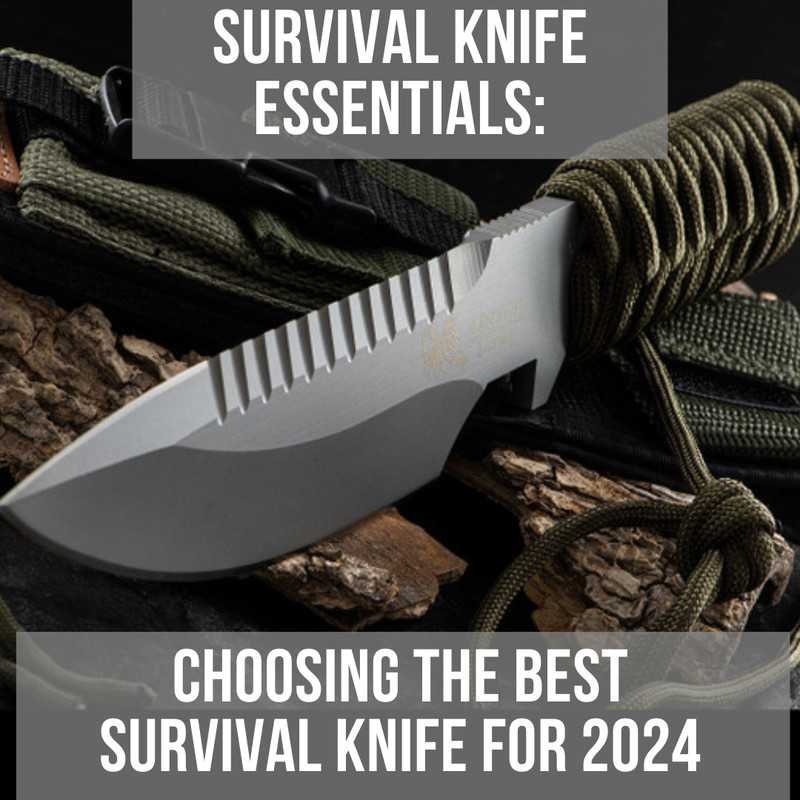How to Choose the Right Survival Knife
24th Feb 2022
A good survival knife is so important, and there are hundreds of different survival knives to choose from. Your choice could mean the difference between life and death, shelter and exposure or food and hunger, so choose wisely! Your survival knife should be capable of helping you to build shelters, open cans, food preparation, cutting firewood, hammering, first aid and much more, so it's essential that you choose one of high quality.
Survival knives come in different shapes, sizes and there are many features to think about when choosing the right one. Here are some of the main factors we think are important to consider when looking for the right survival knife for you:
Fixed Blade
Whilst a folding knife is easier to carry on a day-to-day basis, a fixed knife may be better suited in an outdoor survival situation, as it’s a much more reliable tool to own. The chances of a fixed blade breaking from pressure are very slim, as it's a solid piece of metal. If you are camping, backpacking or undergoing extreme outdoor activities, then the fixed blade knife would be a much better option for longevity and reliability. A fixed blade knife is a little harder to carry around with you, as it requires a sheath, so we'd recommend carrying a folding knife too if you’re an avid adventurer.
Size
Adventuring is all about being agile, and lightweight, to get the best from your experience. It is really important that you choose a knife that’s easy to carry around and that doesn't get in your way. If you choose something that is big and heavy it could possibly slow you down. However, on the other hand, a smaller knife won't be as good for tasks like chopping wood and preparing food. Ideally, you need to look for an all-around survival knife that's approximately 25cm overall (10").
Tang
The "tang" describes how far the blade extends into the handle of your knife. A partial tang that only extends into half or a quarter of the handle, which means that it may become weaker than a full tang. A full tang can make your knife handle much stronger, allowing it to be more reliable on your journey. It can also balance out the knife meaning it'll be easier to carry when using it for building shelters, opening cans or cutting firewood.
Straight Edge
There are many different options you can choose from when it comes to the design of the knife, however we would recommend a straight edge knife for adventuring purposes. A straight edged knife is known to be more versatile, can be sharpened much easier and also better for carving, which can help when preparing food or cutting firewood to keep you warm.

Sharp Point
It is ideal to choose a knife that is very efficient, because of the general wear and tear of knives, it is important to keep them sharp. This is a very important feature to consider that might not even cross your mind, you should take into consideration the sharpness of your knife. We'd highly recommend going for the sharpest and the pointiest you can find!
Saw Back
Some knives are equipped with a saw blade cut in to the top edge of the blade- clearly, cutting down a tree with these small blades would be a tough ask. However, these blades come in to their own when it comes to shelter building - if you score your timber with the saw back of your knife, you're giving something for your binding cord to grip into, keeping your shelter stronger. (Thanks to Rod for this tip).
Blade Material
Survival Knives are either made out of carbon steel or stainless steel.
Carbon steel is generally stronger, which is suitable for survival activities such as chopping and cutting wood, and it's also easier to sharpen out of the two. However, carbon steel can rust quite quickly, so if you plan on traveling for a long time period then this might not suit your needs.
Stainless steel however is much more rust resistant, but can also be quite difficult to sharpen. But if you plan on travelling for a long period of time, and find yourself near water, caught in rain or in a wet environment, then you'll probably want to go for the rust resistant stainless steel.
Although, it's all down to your preference of whether you want your knife specifically for easy food preparation, or you want something rust resistant that will last you a bit longer.
Different situations call for different needs, therefore there isn’t one perfect survival knife for everyone, it’s up to you what you require from it the most. But it is important that you consider the environment you’re going to be in, and the daily tasks you’re going to be performing.
You can visit our website here to view our range of survival knives. Alternatively, if you have any questions, our team of experts are on hand to help on 033 0300 0400.







